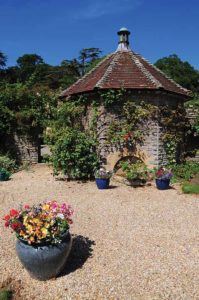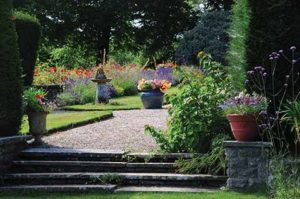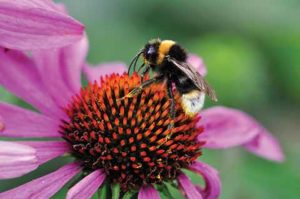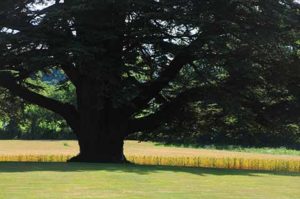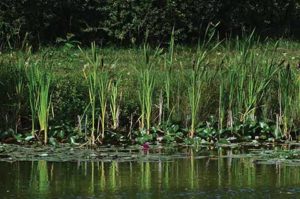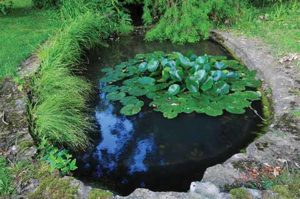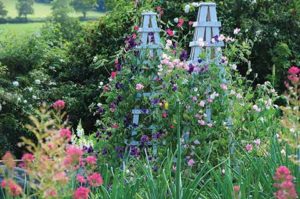Dorset Garden – Frith House
Susy and Colin Varndell explore a garden in the north of the Blackmore Vale
Published in May ’18
Frith is a small hamlet to the east of Purse Caundle which is quite difficult to find! It is reached by a long drive that is surrounded by wide, expansive views, and which leads to the actual house. The full effect of the location of the house is not realised until you walk through a gap in a yew hedge from where you park the car. You can then marvel at the setting of this magnificent Edwardian house, dominating the broad and wide-open landscape with its distant views. The other thing you might notice is the wind, which whistles across the farmland towards the house and which makes a warm jumper advisable.
In front of the symmetrical, rose-covered front elevation is a formal border of roses dominating the view. Rosa ‘Frensham’, a Floribunda bush rose with thorny stems and clusters of bright-red, semi-double flowers, gives definition to this linear feature. The wide stone steps leading up to the house suggest an elegance of times past. The numerous terracotta pots are filled with bright annuals such as lobelias, pelargoniums and petunias and are placed in strategic points around the gravel path surrounding the house.
The expansive lawn in front of the house, which can be very wet in winter, is adorned by majestic cedars. These imposing structures, with their low-slung branches silhouetted against the open sky, create a frame for the view beyond. The effect is stunning. Standing on the terrace, admiring the beautiful stone steps, pots overflowing with colour and the rose bed, one’s eye is irresistibly drawn to the wider landscape which the house and garden occupy. The near view is filled with those wonderful cedars but your eye is led seamlessly down to fields of wheat and the agricultural view beyond.
The game larder, located alongside the house, is an interesting octagonal feature, where game was hung and stored during the meat maturation process. This building is now surrounded by climbing roses and ornamental pots, filled with scented pelargoniums and verbenas. A Lutyensesque fountain adds to the ambience of the setting.
Having explored around the house, your eye will be caught by an interesting-looking bridge which leads to a series of lakes. The lakes were created in the early 1970s but the bridge is a much more recent addition. It was measured precisely, and then ordered over the internet, so there was no room for error with the calculations. The wildflower meadows beside the path leading to the ornate bridge are filled with a wide array of cheerful wildflowers such as oxeye daisies, knapweed, lady’s bedstraw, selfheal, meadow vetchling, ribwort plantain, Solomon’s seal and meadow sweet.
The walk around the lakes gives an alternative view of the house and garden as well as an insight into a further collection of wild flowers, which enjoy the wetter conditions. Tufted vetch, bulrush, purple loosestrife, common centaury, fleabane, clover, spear thistle, black medic, St John’s wort all thrive in this environment next to the lakes and attract an array of invertebrates. Six spot burnet moth, large white, gatekeeper and meadow brown butterflies were all seen on this rather windy day.
The kitchen garden is an enchanting mixture of neat raised beds contrasting with the vibrant, vigorous vegetables and flowers, which thrive in this location, no doubt aided by a good source of horse manure. The freely flowering sweet peas obviously enjoyed the support of their elegant obelisks and they looked most attractive with the flowers tumbling out of the colourful holes. Lettuces, onions, beetroot, cabbage, carrots, runner beans and sweetcorn were interplanted with zinnias, nasturtiums and marigolds. This plant community was obviously working well as all the plants looked strong and healthy. The benefits of such companion planting is clear when it works so efficiently and is an organic way to protect crops from pests, as well as improving pollination for fruit and vegetable crops.
The many magnificent yew and beech hedges throughout the garden act as a backdrop to much of the planting as well as a windbreak against those chilling breezes. The obvious downside to these structures is the amount of trimming that is needed to keep them in check.
Leave yourself plenty of time to visit this garden as there is much to explore and enjoy. And don’t forget your warm jumper, as you are unlikely to visit on a windless day!
